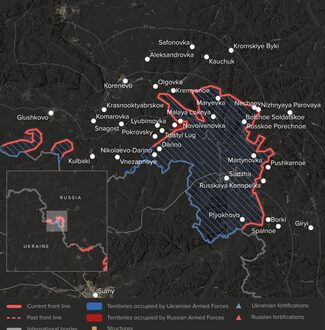Like our earlier reports on the combat situation in Ukraine, this article takes stock of the recent developments on the battlefield based on open-source information. Meduza has condemned Russia’s invasion of Ukraine from the very start, and our detailed military analyses are part of our commitment to objective reporting on a war we firmly oppose.
Key updates as of October 31, 2024
Following their capture of Selydove, west of Donetsk, Russian forces have launched an operation to encircle Kurakhove, a critical logistics hub for Ukrainian troops in southern Donbas. A Russian mechanized column has already pushed into the city’s eastern outskirts, though not without equipment losses along the way. Additional Russian units are pressing in from the north (from the direction of Selydove), and from the south (from the direction of Vuhledar). Ukrainian defenses to the south of the city appear especially weak; after a chaotic retreat from Vuhledar, the brigades seem worn out, and even reinforcements sent from Zaporizhzhia haven’t been enough to help. Meanwhile, in Russia’s Kursk region, Ukrainian forces have managed to hold off Russian troops advancing along the border toward Sudzha — though likely only temporarily.
Meduza has condemned Russia’s invasion of Ukraine from the very start, and we are committed to reporting objectively on a war we firmly oppose. Join Meduza in its mission to challenge the Kremlin’s censorship with the truth. Donate today.
Russia
Kursk region
Last week, Russian President Vladimir Putin claimed that 2,000 Ukrainian soldiers were encircled in the Kursk region. He was likely referring to a group of several hundred Ukrainian troops who retreated from the village of Olgovka, east of Korenevo, and took cover in the Olgovskaya Grove — a large forest southeast of Olgovka, along the Korenevo-Sudzha road. Judging by open-source videos, they aren’t fully surrounded. While Ukrainian forces have lost control of the main road between Korenevo and Sudzha, they still control the route from Malaya Loknya, which winds through fields and ravines.
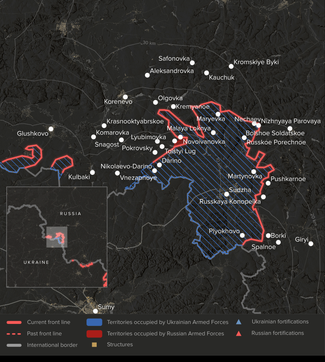
Ukrainian forces are still attempting to mount a counterattack toward Olgovka, using battalions from the 47th Mechanized Brigade, which were redeployed from near Pokrovsk and are equipped with Western weapons, including Abrams tanks and Bradley infantry fighting vehicles. For now, however, the area around Novoivanovka and Zelenyi Shlyakh remains under Russian control.
Meanwhile, Russian forces are also attacking the Ukrainian stronghold in the Kursk region from the east. A week ago, they made an unsuccessful attempt to capture the village of Plekhovo, south of Sudzha, with an armored column. Now, Russian armored vehicles have pushed into the village of Russkaya Konopelka, east of Sudzha.
The main targets of the Russian offensive here are the road linking Sudzha and Sumy, which supplies the entire Ukrainian grouping in the Kursk region, and the Sudzha border crossing. However, Russian forces still have a way to go. Their advance has been slow, with troops covering only five to seven kilometers (about three to four miles) before having to pause to reinforce with artillery, supplies, and reserves. This pace has given Ukrainian troops time to strengthen defenses around Sudzha, where they’ll likely try to hold off the Russian advance.
Ukraine
Selydove, Kurakhove, and Vuhledar
Russian forces easily captured the relatively large city of Selydove, south of Pokrovsk, with a tactic they’ve frequently used in recent months: they surrounded the city from three sides and took control of the high ground on the outskirts, forcing Ukrainian troops to retreat to avoid encirclement. They used the same approach to capture Hirnyk, a city just southeast of Selydove. Currently, the Russian army is storming the nearly encircled settlement of Kurakhivka, as well as the villages between Selydove and the Kurakhove Reservoir.
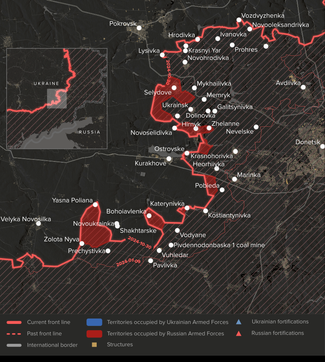
Soon, Russian forces will advance from the north along a broad front toward the Kurakhove Reservoir, forcing all Ukrainian troops to the west of it. Beyond the reservoir lies Kurakhove, a crucial transport hub for Ukrainian forces in southern Donbas. Russian troops have already reached the city’s eastern outskirts, but they’re unlikely to launch a direct assault. Instead, they’ll probably encircle the city from the north (along the reservoir’s western edge), east, and south — where a substantial Russian contingent from the Eastern Military District, fresh off the capture of Vuhledar, is rapidly advancing.
After Vuhledar’s fall, the southern front saw a few weeks of relative quiet, but in late October, Russian forces launched a new, powerful offensive. Russian units are advancing north toward Kurakhove in three groups. They quickly captured two villages, Shakhtarske and Bohoyavlenka, where Ukrainian battalions had fallen back after losing Vuhledar. Shortly after, Yasna Polyana, north of Shakhtarske, also fell. Battles are now underway for Novoukrainka, situated between Bohoyavlenka and Shakhtarske. Altogether, Russian forces have advanced eight to 10 kilometers (about five to six miles) northward.
The Ukrainian command has redeployed units from the 128th Mountain Assault Brigade from Zaporizhzhia to Shakhtarske, but so far, they haven’t managed to halt the Russian advance. Losing Kurakhove would effectively spell the end for Ukraine’s defense across all of southern Donbas, from Velyka Novosilka to Selydove.
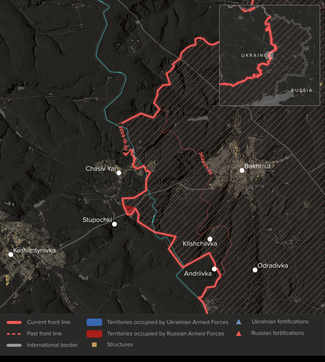
Kupyansk, and Svatove
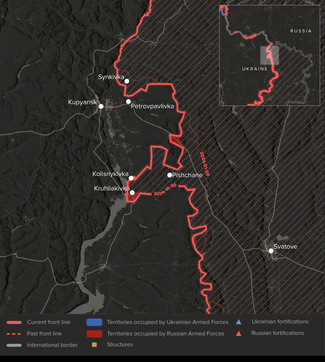
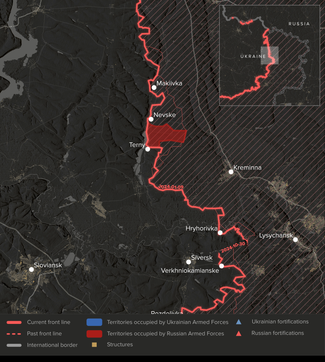
The red dots show recent events, and the gray dots show earlier events. Black indicates the approximate contact line as of the last update; the red and blue areas mark places occupied (since early September) by Russian and Ukrainian forces. Clicking on them will provide additional information. Air strikes are marked with a special icon, ground operations with dots. Click on the point on the map to pull up source links.
 Eurasia Press & News
Eurasia Press & News
